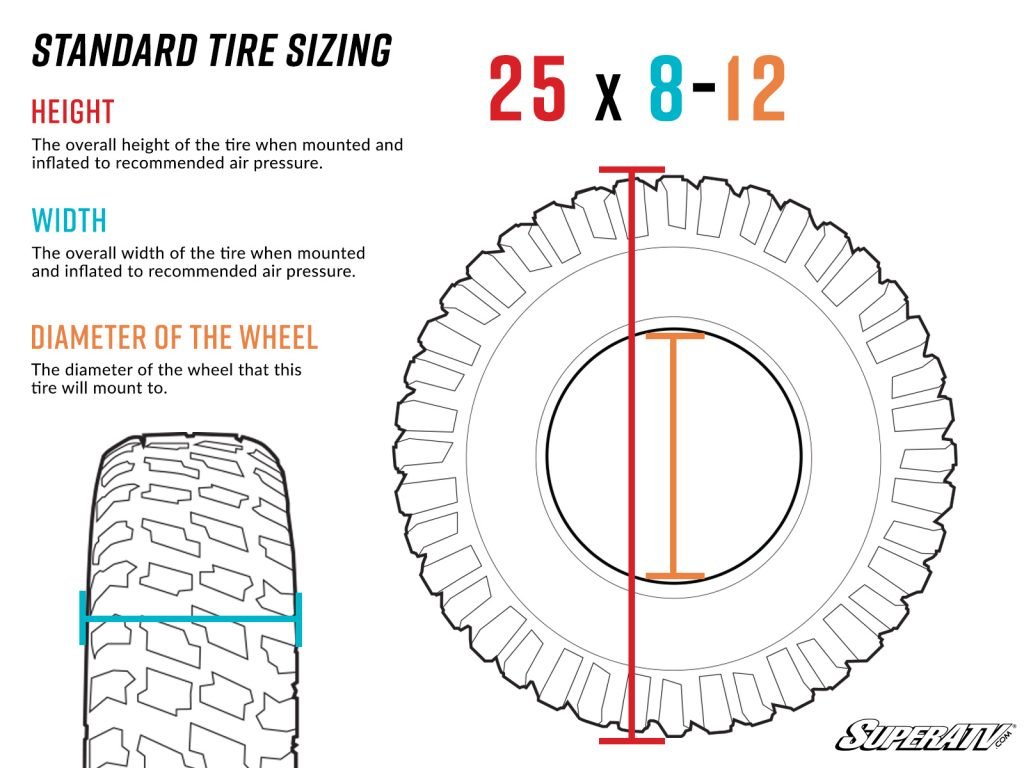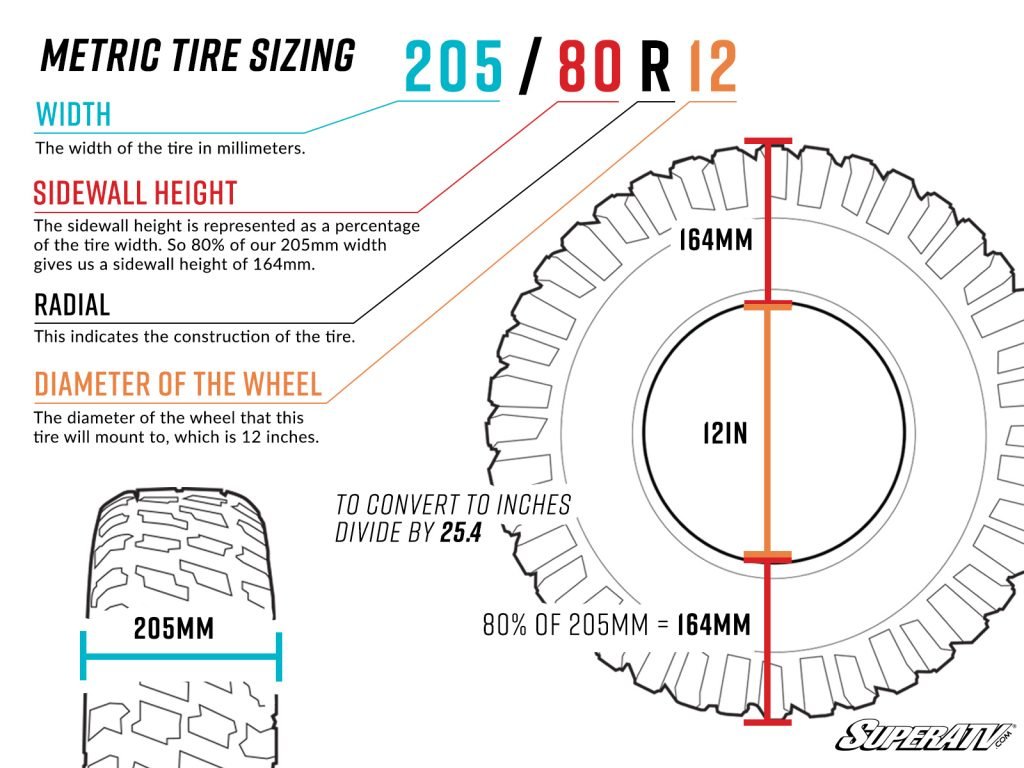ATV Tire Size Explained: A Comprehensive Guide
Your quad is a do-anything machine. ATV’s are great for getting things done and for recreation too. But now you’re looking at your tires. Maybe you’ve blown one or they’re getting bald. Or maybe you just want a more aggressive tread pattern and a bigger tire. The problem is you’re a little lost when it comes to your ATV tire size.
How big can you go? Should you go big? How do you even know what all these numbers represent?
Don’t worry, we’ve got you covered. We’ll answer all those answers and more in this comprehensive guide.
How Do You Read ATV Tire Sizes?
So, you’re shopping around for tires and you see one listed with a size like 26×10-12. Or, worse yet, you find something listed like 206/80R12.
What the heck does all that mean?
First, you need to figure out if you’re dealing with standard or metric ATV tire sizes.
ATV Tire Size Explained: ATV Tire Sizes: Standard Tire Sizing Chart
Standard format is much more common on ATV tires than metric. You might see a tire size written 26×10-12 or, occasionally, 26x10x12. This format is pretty straightforward. It uses three numbers to sum up the size:
Tire diameter in inches
Tire width in inches
Wheel diameter in inches

ATV Tire Size Explained: ATV Tire Sizes: Metric Tire Sizing Chart
If you see a tire size that looks like this: 205/80R12, you know you’re dealing with metric. The metric format is exceedingly rare for ATVs and odds are you’ll never come across it. But if you do, the letter thrown in the middle of those numbers is a dead giveaway. In metric, you always have three numbers and a letter:
Tire width in millimeters
The aspect ratio as a percent
A letter for construction type (usually “R” for “radial”)
Wheel diameter in inches
There may be other numbers and letters before and after these, but they’re not important for understanding your ATV tire size.

Breaking Down ATV Tire Sizes by the Numbers
Knowing how to read those tire sizes is just the first step. You really need to know how to use them. Is 26 inches a reasonable diameter for your quad? What kind of width do you need?
Tire Diameter Breakdown
When you’re considering replacing all of your tires, you’ll want to make sure you get something that will actually fit on your stock vehicle.
Your typical ATV tire diameter fits within a range of about 20 inches for the smallest machines to about 30 inches for your more factory mud-equipped machines.
Basically, your quad will typically fit into one of few categories:
Sport quads—20 to 25 inches
Utility quads—24 to 28 inches
Factory mud or rock equipped quads—27 to 30 inches
Keep in mind that you’ll want to keep within a couple inches of your stock tire size. If you go too big, you’ll start to rub on your fenders (among other issues). If you go small—well, that’s just silly.
Tire Width Breakdown
Tire width is easier to understand. Choosing the right tire width has a lot to do with your own preferences and riding style.
A wider tire tends to give you a flatter tread pattern and more grip. A narrow tire gives you a little more control.
ATV’s usually have a wider tire on the rear than on the front to get the best of both tires. A typical rear tire on a quad will be 10 to 11 inches wide while a front tire will be 7 to 8 inches wide.
But matching your tire width to your riding style isn’t the only thing you need to consider. You also need to make sure it’ll physically fit on your chosen wheel. There are two main ways to make sure it’ll fit.
Check the tire manufactures wheel recommendation. They should provide a range of wheel widths that the tire is designed to work with.
If you can’t find that info, the general rule of thumb is to go with a wheel that’s about two inches narrower than your tire’s width. This is a general guideline and not guaranteed to work for every tire, but our experience shows that it’s right most of the time.
Wheel Diameter Breakdown
This one is non-negotiable. You have to make sure your tire’s wheel diameter matches your actual wheel diameter.
Most off-road wheels tend to be 10 to 12 inches in diameter—which is convenient considering most off-road tires are designed to fit those wheels. That’s a good size as it gives your tire plenty of cushion between the tread and rim, which results in smoother rides and more protection for your rims.
Of course, you can end up with bigger wheels if you have bigger tires, but we’re getting ahead of ourselves.
Choosing the Right Size Tires for Your ATV
You don’t need any old tire. You have to choose the perfect ATV tire size for you. After all, you ride your own way and have your own needs.
We’re going to simplify ride style to three main types:
Work/chores
Trail/dune riding
Rocks/mud riding
For a workhorse ATV, it’s not a bad idea to stick with stock. It’ll give you the expected traction and power you need.
Trails and dunes demand high traction, and you get that by going wider. You don’t necessarily need a taller tire, but a wider one will give you the grip you need.
Dominating rock gardens and taking on bounty holes is done best with a big tire. But going big isn’t as simple as just buying the biggest tire you see.
Can I Put Bigger Tires on My ATV?
The short answer is yes.
Here comes the long answer.
Every ATV has a theoretical maximum tire size it can fit without modifying the suspension. It’s typically about one to two inches bigger than your stock tires. So if your ATV came with a 27-inch tire, you could probably fit a 29-inch tire without too much trouble.
But what if you want to go bigger?
That takes some work. You’ll either need to invest in a lift kit or some offset A-arms. These types of kits will often tell you what the max tire size is when you have them installed.
You can’t go big without some consequences though. Namely, you’ll lose torque due to the increased diameter (big tires like a high-gear kit!) and the extra weight. The weight can also put extra strain on your clutch and shorten the life of your clutch belt.
Luckily, you can get your torque back with a transmission gear reduction.
You can also bolster your clutch with heavy-duty drive belts and eek out even more torque with a clutch kit.
So now that you’re equipped with knowledge, go equip yourself with some tires. Get the ATV tire size you want, and ride with confidence.
By Kavan Wright, www.superatv.com
